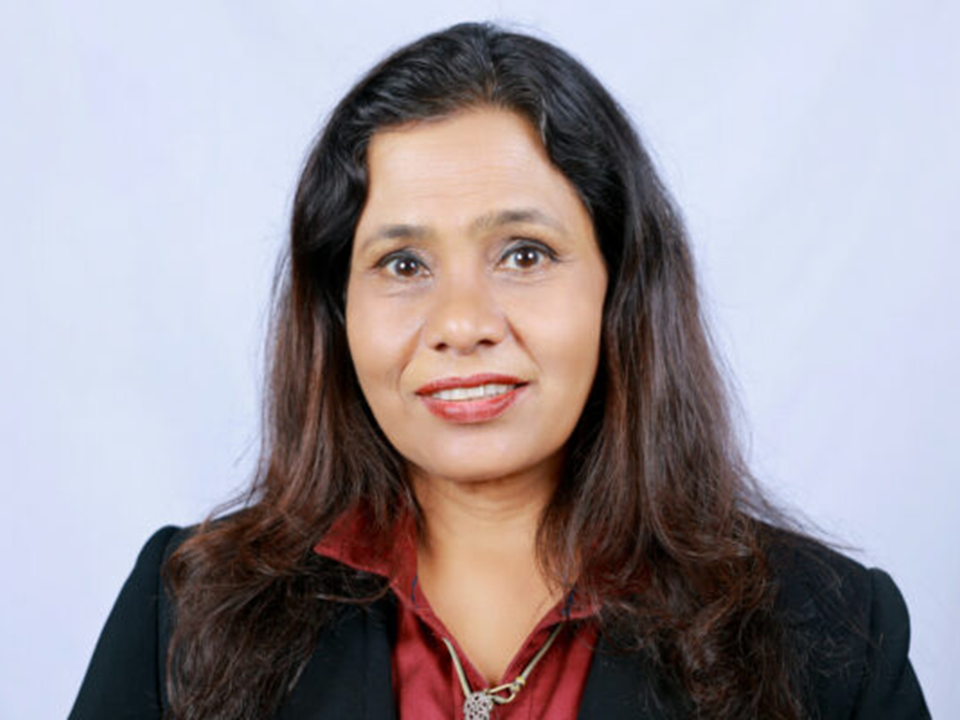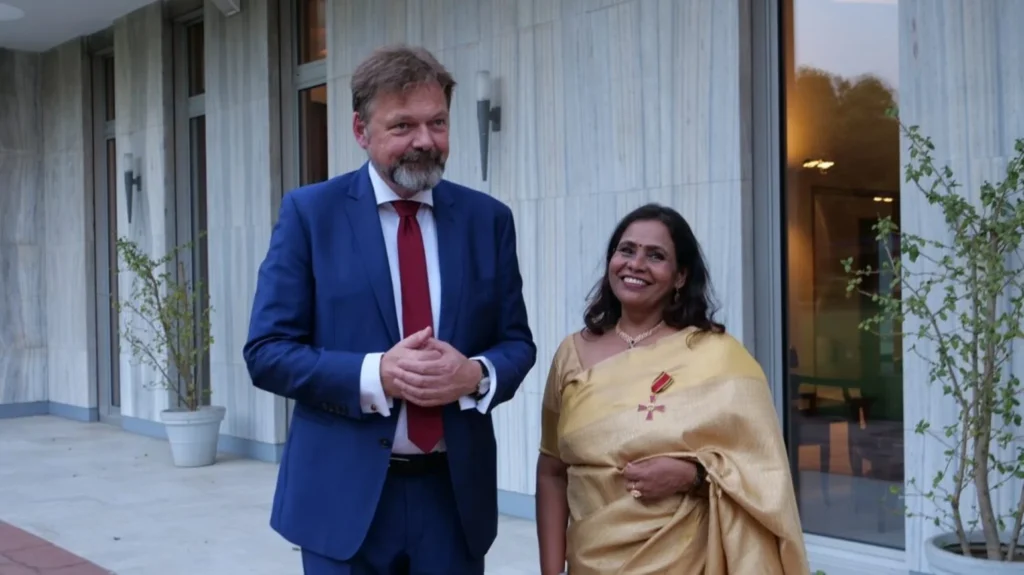
Anandi Iyer, Director of the Fraunhofer Office India and recipient of the German Federal Cross of Merit, is a key architect of Indo-German scientific and innovation relations. In our conversation, she emphasizes that „relationships are the true currency of this world“ and describes how, through perseverance and strategic network-building, she has firmly anchored the concept of applied research in India. Seeing vast potential in the complementary strengths of both nations – from sustainability and digitalization to the empowerment of women in STEM – she calls on the younger generation to shape this new era of collaboration with passion and purpose.
You were recently awarded the Federal Cross of Merit („Bundesverdienstkreuz“) for your contributions to Indo-German collaboration. Looking back, what were some of the biggest challenges on this journey?
The biggest challenges always came from my efforts in breaking the old mould and pushing through innovative ideas. When we started Fraunhofer activities in India in 2018, the innovation ecosystem was fairly fragmented. India’s R&D contribution to GDP has remained less than 1% since then, and it was not clear if industry would be willing to pay for proprietary outsourced research. But we dug our heels in, believed in the growth story of India, and it has paid rich dividends. We had to really evangelise the concept of applied research in India, and work together with Industry, Government, Academia and others to crank the innovation ecosystem. Fraunhofer and its model of innovation was not very known in India, so it started with brand building, acquisition of clients and curating relationships. And particularly being a woman in the field of science and technology, one has to prove oneself every day, each time.
And the most rewarding moments?
Rewards were many: The support of some amazing mentors like Dr R. A. Mashelkar, Dr R. Chidambaram, Prof Sadagopan and many others who respected talent and opened doors for me. The impact of the work I did was the most rewarding. We have actually busted the myth that Indian Industry will not pay for research, having earned over Euros 70 Million in the last few years, and working with all stakeholders very closely to accelerate research and innovation. And of course, amazing colleagues, both in India and Germany who have now become great friends. I always believed that the best currency in this world is relationships, and I am glad that my work was not only interesting but also fun and rewarding.
Having worked extensively at the intersection of science, research, and policy, how would you describe the key differences – and complementarities – between innovation cultures in Germany and India?
There are many similarities and differences but I believe it a very complementary relationship that should be leveraged to the fullest. In India, Innovation is largely driven by service models and cost arbitrage. In Germany, innovation comes from Deep Tech and product innovation.
In India, the large companies are drivers of innovation, unfortunately the SMEs find it very difficult to access technology and finance. In Germany, the SMEs or Mittelstand are drivers of innovation and are tech champions.
In India, we do not have a large pool of researchers doing their PhDs and Postdocs, most of them relocate elsewhere. In Germany, nearly 30% of our intellectual capital in Fraunhofer comes from the young researchers who question status quo and do their PhDs and then go into the industry. This is a bridge building exercise and helps to connect industry to academia very closely.
In India, Government spends more into innovation, whereas in Germany the model is more mature with industry contributing nearly 3-4 % of its turnover into R&D. Germany also has a very strong ecosystem of basic applied and industry driven research. In India we have excellent capabilities for fundamental research but our research- to-market competencies and infrastructure are being developed as we speak.
Finally, innovation infrastructure is a very critical component of the entire value chain. India still lacks infrastructure for prototyping, testing and validation at scale. What India has in abundance is the young-qualified workforce, and the entrepreneurship spirit, reflected in our start up ecosystem. In that sphere Germany has a lot of catching up to do, and create more opportunities for start-ups to emerge, and also reduce the risk averse nature.
Fraunhofer has played a major role in building strategic Indo-German partnerships. What current areas of collaboration do you find particularly exciting, especially in light of global challenges like sustainability and digital transformation?
We are working very closely with a few State Governments to establish innovation clusters in Digitalisation, manufacturing, renewable energy and semiconductors. Renewable energy is one of the strongest areas of collaboration, be it solar, hydrogen or EVs. An emerging strategic area of cooperation is semiconductors and microsystems. We are working very closely with MeitY as well as industry bodies such as EPIC Foundation, STPI and IESA to accelerate „Lab-to-fab“ in India. Here too, Germany and India have complementary strengths that can be leveraged for mutual benefit. Circular economy and sustainability are core to Fraunhofer’s research. In India we are working with companies in the field of Water-energy-food nexus and have also set up water innovation hubs and sustainable neighbourhoods in collaboration with Indian industry, civil society and government.
Beyond technical cooperation, cultural understanding is often a hidden key to successful partnerships. In your experience, what helps Indo-German teams overcome intercultural misunderstandings?
Even though it is very often said, that Indians and Germans are similar and have a close relationship since decades, I really believe that we are very different! At the risk of over generalising, and sounding cliched, I highlight certain differences to make the point: India is chaotic creativity and Germany is structured engineering. They speak in monologues; we speak in paragraphs. Germany is monochrome, India is a burst of colour. Germans debate differences, Indians celebrate differences. But we have shared values of democracy, freedom and liberty. I think we have a strong fundament of mutual respect on which we can build our complementary strengths. Communication and levelling of expectations in key to this relationship. A lot of the information asymmetry gets cleared when we talk more, meet more and explore each other’s country through our own eyes, and accept the differences.
I came to Germany for the first time 30 years ago as a young student of German language, and fell in love with this country, its history and its people. Over time, I have built friendships that are family, and demolished many misbeliefs and prejudices that were based on hearsay. I am sure the same holds true for Germans who came to India personally and discovered that their view of India was archaic and based on secondary reports which did not do justice to the multi-dimensional, pluralistic and modern India of today. We need more sustained platforms for engaging with one another.
You have long championed the role of women in STEM in both countries. What structural differences do you observe in how India and Germany support women in science and technology – and what can they learn from each other?
To be honest, I have never really spent too much mind space on the issues or challenges of me being a woman in STEM. I am doing my job, and what I love most. The attitude of men and their view of me does not really figure too much in my world-view. Having said that, when I took over as chairperson of the Women in STEM for G20 when India was the chair, it really opened my eyes to the challenges that a lot of women globally have to face in their quest for professional excellence. Women are a majority in many countries including India, and therefore a critical part of the workforce and yet the system is not conducive to women in professions much less in STEM. More than 50% of women are subject to leaky pipeline, falling out of the workforce due to care-giving positions. This is not only in India or the global south, but all across the world in varying dimensions. The system needs to be calibrated so that women can contribute actively and stay in the productive work force. There are many solutions such as flexible work hours, different roles within the organisation at varying points in their career and support systems that encourage equity. However, we need to empower men (and women) in decision making positions to think more out-of-the-box and listen to the voices of the voiceless women in marginalised areas.
The lack of visibility of women leaders is another challenge and hence we created a moving exhibition of 20 powerful women leaders from India and Germany in science and engineering as well as “Handwerk” which was showcased at the Experiminta Museum in Frankfurt in March 2024. It was a great experience putting these role models together for the young girls in science and hearing the moving stories of grit and resilience from women who broke through glass ceilings.
As our portal marks 25 years of connecting Indo-German voices, what is your message for the younger generation navigating both cultures – and shaping the next phase of Indo-German relations?
For many years, in fact decades, one has been hearing that India and Germany have great potential and that we can create huge value by joining hands. It never really happened!! NOW is an inflection point in our joint history! For many reasons, the world is facing turbulence of unseen proportions, and the equations are changing constantly. With the growing Indian diaspora in Germany, and Germany’s increased interest towards India, I think we have a responsibility to curate a sustained and mutually rewarding relationship based on shared values that will stand the test of time. I am confident that this is a new age of our partnership and look forward to contributing significantly towards this objective.
And we are very much looking forward to it, thank you.

